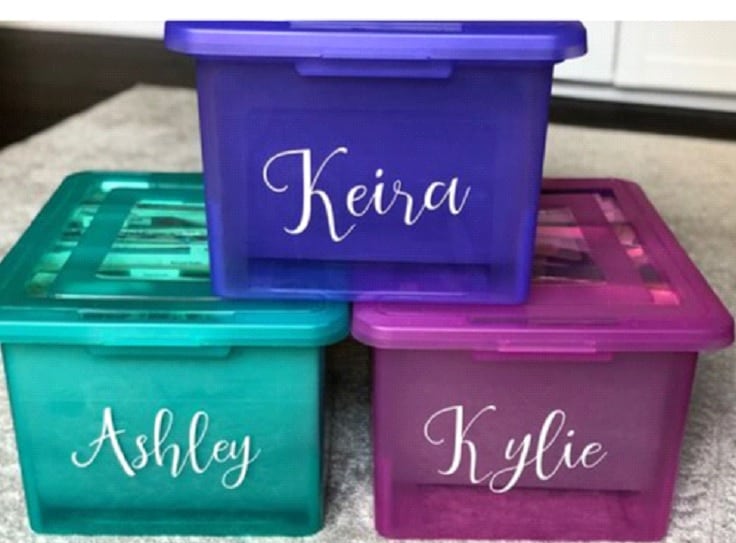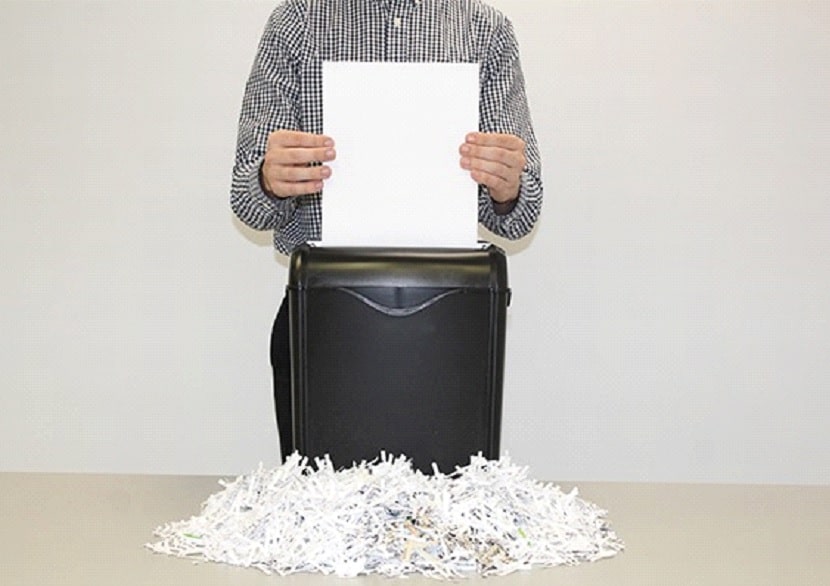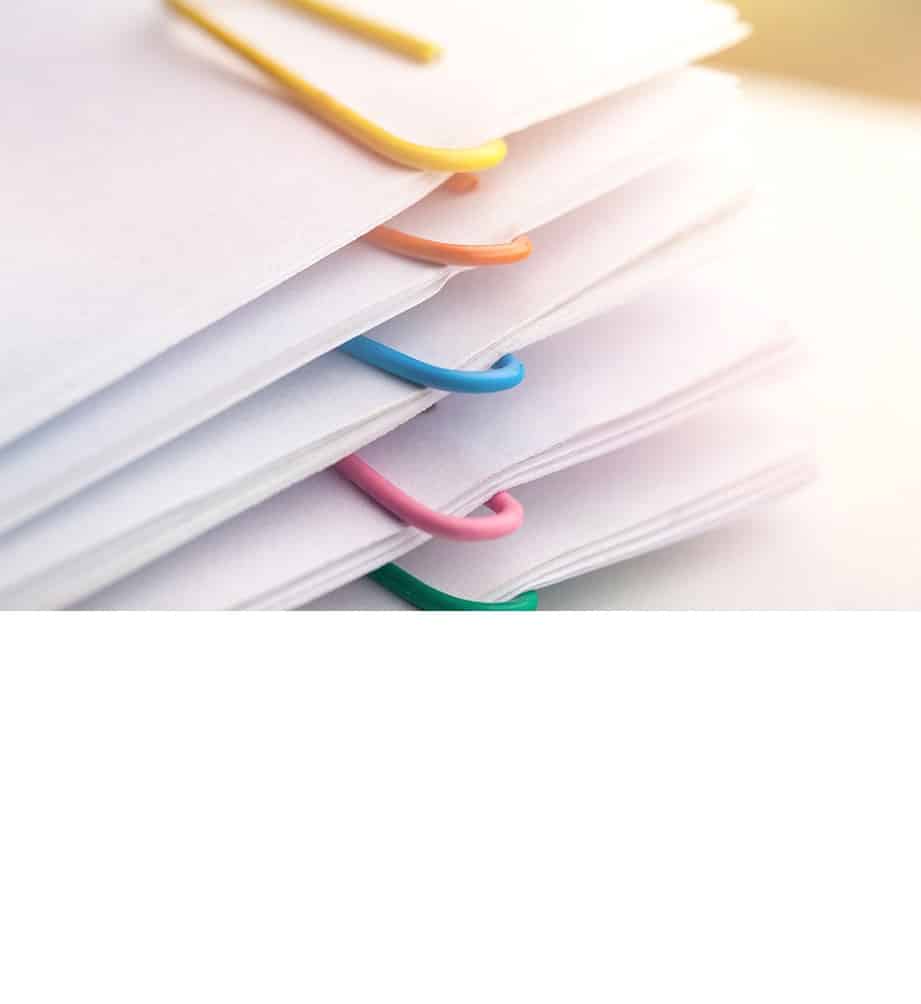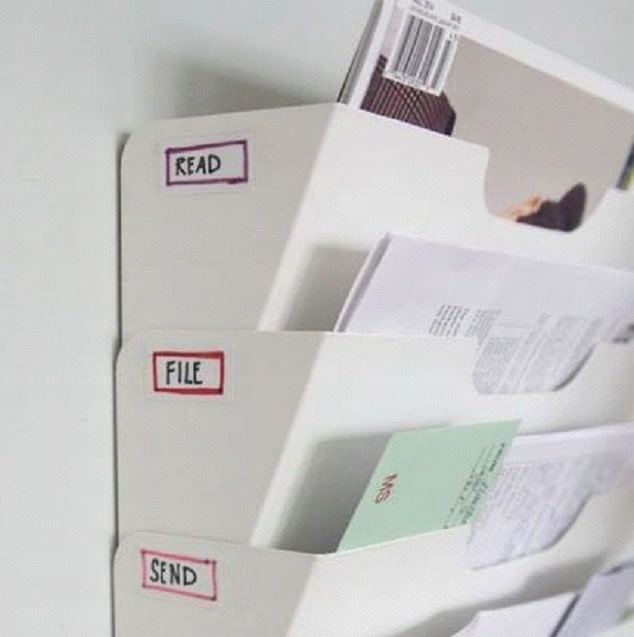
Even in a “paperless” age, we still have documents and paperwork that need filing to keep paper clutter from taking over. The key to paper management is developing a system to handle incoming papers and filing them in a manner that works using logical subject categories.
There are different organizers and ways to set up a system. It is crucial to find one that works with your tastes and personality to be successful.

How To Start The Paper Organization Process
When you start to organize papers, it is essential to understand that the process may take a long time. If you have five or ten years of build-up, do not expect to get your piles under control in a day’s worth of organizing effort.
The first thing to do in paper organizing is to find ample space to place all your papers because you need room to sort and form piles.
It is best to select a place that will not need use until your done. If your project is big, it may take time; consider a cleared dining room table or set up card tables in the living room, so you do not feel overwhelmed and rushed.
Paper organizing requires a couple of steps; The first one is to sort and reduce papers. The second one is to arrange them in a system that keeps them organized.
Categories To Sort Your Papers
In step one, sorting and reducing, establish six main piles to sort your papers:
1. Important and more indefinite documents are those kept permanently but may be subject to change. These items are not accessed regularly, such as social security cards, trust, and wills.
2.Important short-term papers are those that are pending or have a shelf-life. Current business papers, things-to-do lists, or this year’s tax documents are good examples of papers in progress. Short-term papers with a shelf life would be a product warranty.
3.Reference documents are papers we refer to for pertinent data from, such as periodical articles, gardening tips, user manuals, and maps are examples of items to reference.
4.Shred papers are unneeded articles containing private or security information such as passcode lists, financial documents, or customer profiles.
5.Papers that do not belong are those that need to move elsewhere. Children’s drawings, sentimental notes, journals, stage bills, and genealogy documents are examples.
6.Papers to recycle are items that do not need to be shredded but are not required anymore. Examples are periodicals, flyers, junk mail, pamphlets, or reference material that we are not interested in anymore.

Obtain The Right Mindset While You Sort Your Papers
Some papers may overlap in the description but make steadfast decisions while sorting and do not waste time deliberating which pile is the best fit. You have to further break down each of these piles eventually, so make that the time to be particular.
As a professional organizer, I can say that almost everyone spends way too much time reading all the information on each paper when they organize. It is unnecessary to do so, especially in the sorting stages, because it is draining and does nothing but confuse the person. Nine out of ten times, we know what a paper pertains to with a glance.
I find that most sidetracking items are sentimental papers, such as genealogy documents or greeting cards. It is best to emotionally detach from the paper organizing process, preparing oneself with the necessary mindset.
Start by gathering one stack of papers or files at a time to sort into one of the six piles, and do not overthink things. Bound organized files should stay together in their current folders or binder clips.
Tackling The Papers That Need To Go Elsewhere
Once you have sorted all the papers, start with the easiest one: the pile of articles that belong somewhere else. Before returning these items to their respective homes, make sure you want to keep all of them. Now is the time to reduce your papers because it may be a long time before you revisit them.
Many times, we have a large number of sentimental papers and no real place to house them. I love using a memory bin for them; They are basic handled file crates with a professional label on the outside. They can get labeled by person or event such as a wedding.
Shred and Recycling Piles
The following piles to tackle that are easy to deal with are the shred and recycle piles. The recycling pile will be simple since you utilize your current recycling method.

Hacks For Shredding Papers
Your shred pile contains papers that are confidential material and must get disposed of properly. While a personal home shredder is ideal, not everyone has one. Here are some great hacks for discarding your confidential documents:
1.You can always tear or cut papers with Multi-cut scissors by hand. It is important to cut in between lines or words carefully and separate the pieces into different trash cans that deposit into the recycling bin at other times.
2.You can burn papers in a fire pit which is a fast and easy method. Make sure to check cut it down first to avoid large pieces flying out of the pit and into the wind, and check the ashes when done.
3.Compost paper, but cut it down first for best results. When composting paper, make sure it is suitable for composting. Avoid composting paper that might contain high levels of toxic chemicals, like glossy paper.
4.To make your documents unreadable, soak them in a buck of water for at least 24 hours. After soaking, mix the paper-water solution thoroughly to break up the paper. Ideally, use a paint mixer attachment with a drill.
5.Look for a free shredding event in your community. Many local government offices support such services to educate the public on the importance of data privacy. Contact your local library or village office to find out about these events.
In the meantime, keep your sensitive information secure and together.
6.Use a local paper shredding service. Check with your local UPS Store, FedEx Store, or recycling service. Most places offer a low rate per pound, which is cost-effective and time-efficient.
Reference Papers
The next group of papers to sort can be reference items. Above any other class of papers, reference papers greatly vary by person since they relate to a person’s hobbies or interests. Most reference material is the easiest to replicate online.
Commonly, most reference literature becomes outdated quickly as current information and findings surface. Think of an encyclopedia. Ideas and knowledge found in an encyclopedia written ten years ago would not be as relevant as information found on the subject matter today.
I recommend a ruthless reduction of these papers for this reason. Anytime you need to reference diet, nutrition, gardening, or cleaning tips, you are best off referring to the Internet seeking a recent blog on the subject manner. Products, places, or solutions to the subject will be more relatable in the present day.
We sorted our important paper piles into two categories—long-term and short-term. I like to tackle the long-term papers first because selecting classifications is simple, allowing us to ease into our other papers’ categorizing process.

Now we arrive at the papers we need to keep: the long-term and essential permanent documents. Usually, decluttering these items is unnecessary. However, they may be subject to updates such as renewals or changes.
Sensitive Paper Categories
The following are recommended classifications for important long-term documents.
1. Birth/marriage/divorce/death certificates
2. Military records
3. Social Security cards
4. Retirement or pension plans
5. Health insurance information
6. Medical records
7. Passports
8. Driver’s license or government-issued identification card
9. Educational records
10. Immunization/Allergy records
11. Vehicle registration/ownership papers
12. Proof of vehicle insurance
13. Credit reports
14. Trust/estate planning/deeds/will documents
15. Adoption or foster care documents
Sensitive documents need particular care over most papers because they cannot get replaced easily. They hold information that you do not want in the wrong hands. I recommend keeping the originals in a safety deposit box, home safe, or a locked file cabinet. Moreover, fireproof and waterproof safes are preferred. These items also benefit from a plastic sleeve to protect them from spills. If you do not have a fireproof or waterproof storage option, strongly consider one now. In the meantime, use post-it notes to write out your categories and corral each group of papers in binder clips for now. Eventually, you will make labels for your current filing system or whatever filing system you decide to move forward with when you complete the entire sorting process.
Suppose you use or plan to use a safe for these sensitive documents. In that case, you can also photocopy them and keep them filed with your other papers for a quick reference.
Make sure to look into their expiration and jot that date down on the folder’s cover or label. You can also transfer these dates into your calendar and set a reminder on a digital calendar so you can discard these files promptly. Here are some examples of important documents with a shelf life.

Sort-Term Papers
The next grouping of papers to sort out and declutter are our important pending and short-term papers. Our short-term papers will eventually leave the file cabinet but are necessary to keep around. The following are good examples of short-term documents and suggestions on how long to keep them.
Keep tax records 7-10 years
According to the IRS, you should keep tax returns and related paperwork such as W-2s, 1099s, and trade confirmations for a minimum of three years. However, if you want to be on the safe side, you should hang on to these records for seven years if you end up needing to file a claim or in the event of a reporting error. If you own a business, you might need up to 10 years’ worth of data. Confirm with your accountant to be sure. Usually, your accountant has these saved, but keep a hard copy, just in case.
Keep home improvement project paperwork until you move
I recommend keeping every detail of home improvement projects, such as receipts on new windows, appliances, roof, plans, and product information. These could be easy to reference and nice to pass along to new buyers if you were to sell your home.
Keep vehicle history documentation for as long as you own the carr
It’s a good idea to hold on to any documents related to your car’s maintenance and repair. You don’t necessarily have to keep the receipts for every oil change, but keep documentation of bodywork, electrical repairs, engine work, etc.
Additionally, suppose you were ever involved in an accident. In which case, you should keep documents related to the insurance claim and related repairs. If another person was involved, hold on to this paperwork for a year.
You also want to keep a hard copy of the title (in your safe) and registration (in your glove box).
Keep medical billing statements until the insurance carrier has reimbursed you
Suppose you don’t owe any money for a check-up or procedure. In these cases, you don’t need to explain benefits that detail how it was billed to insurance and paid out.
The exception is if you have pending worker’s compensation or other medical claims. Once the bill has been satisfied and paid, you can toss the benefits statements. If there are ongoing disputes or claims, keep all paperwork.
Also, keep medical bills and prescription receipts until tax time if you need them for tax write-offs.
Keep warranties until they expire
There’s a good chance you’ll come across some warranties for products you’ve purchased over the years. If the warranty has expired, go ahead and throw it away.
If there are some that you still need, find the purchase receipt and attach them, so they are ready should need to file a claim. If the company allows you to submit the warranty claim electronically, you can scan both and toss the hard copies.
Keep credit card statements up to one year
Many credit cards offer additional benefits such as extended warranties and purchase protection, so it’s a good idea to save credit card statements related to big-ticket purchases for a year just in case you need to go back for proof of purchase. However, if you have any receipts related to warranties, keep those in the warranty file and not attached to your statement.
Keep insurance policies until they change
There’s no need to keep old auto, home, medical, and other insurance policies, except for the most current coverage summary page. Both your agent and the insurance company will keep electronic copies for years.
It would help if you hung on to your most recent policy booklet, i.e., the actual legal contract. If your insurer makes any policy changes, you’ll receive a new booklet.
Keep receipts for 90 days
In most cases, returns are only allowed within 90 days of purchase. So any receipts for items you purchased that are outside the return window should be tossed. The exception is receipts related to warranty claims and tax purposes, which, as mentioned above, should be attached to any related paperwork and filed to that category.
Pending Paper
Important pending documents are the most critical papers in terms of key placement. These papers are those that we are currently working on, and they also require careful labeling because we need to be able to access them quickly. These papers mean different things to people and directly relate to what they have going on in their life. For example, an open medical claim or remodeling project requires folders particular to the individual. Often, short-term and pending papers overlap and sometimes cause people to create duplicate folders. For the sake of simplicity, you can invent a home filing system that merges both in a logical manner.
Reference Papers
The next group of papers to sort can be reference items. Above any other papers, reference papers greatly vary because they primarily relate to a person’s hobbies or interests. They are the easiest to replicate online; in fact, the information found in reference materials quickly becomes outdated as new ideas and findings make their way into the mainstream public. Think of an encyclopedia. Ideas and knowledge found in an encyclopedia written ten years ago would not be as relevant as information found on the subject matter today.
I recommend a ruthless reduction of these papers for this reason. Anytime you need to reference diet, nutrition, gardening, or cleaning tips, you are best off referring to the Internet seeking a recent blog on the subject manner. Products, places, or solutions to the subject will be more relatable in the present day.
I recommend creating a main header folder for the subject of reference and then use subcategories for all the different files such as gardening, golf, travel, etc.
Once you have all your papers in order, it becomes time to label and file; You can revert to your old filing system or create a new one. Either way, select one that feels right. If your old one failed, ask yourself was it the inconvenience in use or were your labels or classification selections lacking good order.

The following are the best tips and strategies to create successful paper management
#1
It would help if you always created a general heading term and subfiles under an umbrella or general term. Anytime you get too specific in organizing, especially with papers, you increase the probability of making a too-hard system to navigate. Here are some great examples of classifications and related subcategories.
Bank Records (Header or General)
Checking accounts (Subcategory)
Savings Accounts
Safety deposit box list
Loans
Trusts
Employment Records (Header or General)
Employment contracts (Subcategory)
Retirement or pension plans
Social security records
Fringe benefits
Wage statements or paycheck receipts
Resume
Start with fewer and broader categories when creating file folders. Long titles are a sign that you are making the wrong kind of classifications. File with general-header names and use simple subcategories, and you will logically and easily find things.
#2
A color-coding file system is a popular method used to promote ease in finding things. The color-coded filing allows you to find files quicker—your mind associates to colors much quicker than black on white name labels. Color-coded filing systems let you get to the desired area of the filing system very quickly. Color-coded filing saves time.
#3
Select a filing organizer that fits your personality. There are hanging file folders that can get placed in cabinets or in carrying crates. Using several easy-to-carry containers instead of one giant filing cabinet has perks. You can move the one you need close to the desk while you work. It is easy to separate individual bins by type. For example, one crate can contain reference papers and other insurance documents.
Besides hanging folders, you can use project cases to divide papers. I use this system for my documents because they are small, and I am paperless for the most part. I love these organizers because they are completely portable and easy to move to your desk or take to the office; each folder is a different subject. I have clients that love several wall folders or rolling carts to divide papers. Whatever works so that you can retrieve and place documents back easily is the goal.
#4
At a later date, take a look at what’s in your files. Usually, you find that a file is either underused or bulging. If you find that you have only one or two things in a file folder, find or create a file that’s broader in scope. Alternatively, if you find that a folder is overflowing with contributions, create subcategories, either by topic or by dates.
Start with fewer and broader categories when creating file folders. Long titles are a sign that you are making the wrong kind of classifications. File with general-header names and use simple subcategories, and you will logically and easily find things.
#5
Shred, file, and tend to papers regularly to prevent disorganization.
#6
Create an incoming paper system to prevent paperwork from sprouting all over the place. Once you have a filing system organized and in place, you need to set up an incoming system that will stop piles of new paperwork from sprouting all over the place. The key is to keep the system simple and tend to it often. Two incoming bins are needed—one for filing and the other to take action. The filing should get handled regularly, like every week, because no one likes to file too much at once. The action bin is for everything else, such as bills to pay or invitations to address. Also, have a trash can and personal shredder nearby so that when you are handling incoming papers, you can get rid of them and forego the bins. Lastly, create an outgoing box for Mail that needs to exit the home.

